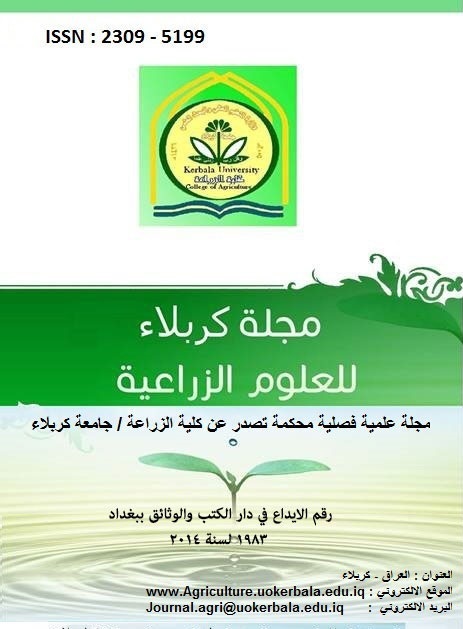Effect of foliar-applied trehalose on wheat (Triticum aestivum L.) under salt stress condition
DOI:
https://doi.org/10.59658/jkas.v4i4.112Abstract
A pot experiment was conducted in wird canopy of agriculture division-Kerbala university to asses the role of Trehalose adding on wheat cultivar (Fatih class) was planted during the winter season 2015 - 2016. Factorial experiment was designed using a completely randomized design (CRD) two factors and three replicates. first factor included four types of water different in the level of salinity which is (2, 4, 6 and 8 ds m-1) and the second factor include four Trehalose concentrations (T) (0,5,10 and 15 mg L-1) giving 48 experimental units. Plant height , flag leaf area, concentration of proline the activity of SOD and CAT has been studied in the flowering phase 100% and trehalose content in the straw wheat plant . The result showed that type of irrigation water affect on all traits studied , given salt level(8 ds m-1) the highest in some of the qualities of which the concentration of proline and concentration activety of enzyme SOD and enzyme CAT and content trehalose in the straw while gave salt level (8 ds m-1) lower rates studied Characteristics of which plant height , flag leaf area.
The levels trehalose added had significant effect on all traits, where the level of 15 mg L-1 ,gave The highest rate in most of qualities has been studied include the plant height and flag leaf area and SOD and CAT activity , content trehalose in the straw, While gave level 15 mg L-1 lower rate in concentration of proline. The study results showed significant effect of interactions between water types and trehalose added in all traits , as it found the best treatment of interference when spraying trehalose sugar in concentration of 15mg. L-1with irrigation water level of (8 ds m-1 ).
Downloads
Published
How to Cite
Issue
Section
License
Copyright (c) 2017 Copyright (c) 2024 is the Author's article. Published by the Journal of Kerbala for Agricultural Sciences under a CC BY 4.0 license

This work is licensed under a Creative Commons Attribution 4.0 International License.
Licensing Terms
All articles are published under a Creative Commons License and will be directed to the Creative Commons Attribution 4.0 International License (CC BY 4.0) That permits use, distribution, and reproduction in any medium, provided the original work is properly cited. This license also allows the work to be used for commercial purposes.
Use by both non-commercial and commercial users
This content is licensed under a Creative Commons Attribution 4.0 International (CC BY 4.0) license, permitting use by both non-commercial and commercial users. Individual users may access, download, copy, display, and redistribute the articles to colleagues, as well as adapt, translate, and text- and data-mine the content, subject to the following conditions:
- The author's moral rights, including the right of attribution and the right to protect their work from derogatory treatment, are respected.
- Where content in the article is identified as belonging to a third party, users must ensure that any reuse complies with the copyright policies of the owner of that content.
- If the article content is reused for research or educational purposes, users should maintain a link to the appropriate bibliographic citation, including the DOI and a link to the published version on the journal's website.

